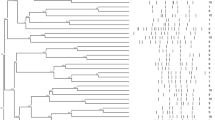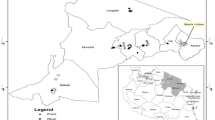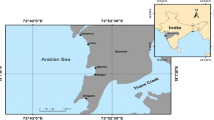Abstract
The presence of Clostridium perfringens in water is generally regarded as an indicator of fecal contamination, and exposure to waterborne spores is considered a possible source of infection for animals. We assessed the presence and genetic diversity of C. perfringens in water sources in a zoological park located in Madrid (Spain). A total of 48 water samples from 24 different sources were analyzed, and recovered isolates were toxinotyped, genotyped by fluorophore-enhanced repetitive polymerase chain reaction (rep-PCR) fingerprinting and tested for antimicrobial susceptibility. C. perfringens was recovered from 43.8 % of water samples and 50 % of water sources analyzed. All isolates (n = 70) were type A and 42.9 % were β2-toxigenic (i.e., cpb2+), but none contained the enterotoxin-encoding gene (cpe). Isolates belonged to 15 rep-PCR genotypes and most genetic diversity (88 %) was distributed among isolates obtained from the same sample. Most isolates displayed intermediate susceptibility (57.1 %; MIC = 16 μg ml−1) or resistance (5.7 %; MIC ≥ 32 μg ml−1) to metronidazole. No resistance to other antimicrobials was detected, although some isolates showed elevated MICs to erythromycin and/or linezolid. Finally, a marginally significant association between absence of cpb2 and decreased susceptibility to metronidazole (MIC ≥ 16 μg ml−1) was detected. In conclusion, our results reveal a high prevalence of C. perfringens type A in the studied water reservoirs, which constitutes a health risk for zoo animals. The elevated MICs to metronidazole observed for genetically diverse isolates is a cause of additional concern, but more work is required to clarify the significance of reduced metronidazole susceptibility in environmental strains.

Similar content being viewed by others
References
Silva RO, Lobato FC (2015) Clostridium perfringens: a review of enteric diseases in dogs, cats and wild animals. Anaerobe 33:14–17
Uzal FA, Freedman JC, Shrestha A, Theoret JR, Garcia J, Awad MM, Adams V, Moore RJ, Rood JI, McClane BA (2014) Towards an understanding of the role of Clostridium perfringens toxins in human and animal disease. Future Microbiol 9:361–377
Deprez P (2015) Clostridium perfringens infections—a diagnostic challenge. Vet Rec 177:388–389
Songer JG, Uzal FA (2005) Clostridial enteric infections in pigs. J Vet Diagn Invest 17:528–536
Uzal FA, Songer JG (2008) Diagnosis of Clostridium perfringens intestinal infections in sheep and goats. J Vet Diagn Invest 20:253–265
Buck JD, Shepard LL, Spotte S (1987) Clostridium perfringens as the cause of death of a captive Atlantic bottlenosed dolphin (Tursiops truncatus). J Wildl Dis 23:488–491
de Carvalho MA, Santos PS, Nogueira SS, Lessa F, Almeida Vdos A, Leça-Júnior NF, Salvarani FM, Lobato FC, Nogueira-Filho SL (2011) Necrotic enteritis in collared (Pecari tajacu) and white-lipped (Tayassu pecari) peccaries. J Zoo Wildl Med 42:732–734
Greco G, Madio A, Martella V, Campolo M, Corrente M, Buonavoglia D, Buonavoglia C (2005) Enterotoxemia associated with beta2 toxin–producing Clostridium perfringens type A in two Asiatic black bears (Selenarctos thibetanus). J Vet Diagn Invest 17:186–189
Silva RO, D’Elia ML, Tostes Teixeira EP, Pereira PL, de Magalhães Soares DF, Cavalcanti ÁR, Kocuvan A, Rupnik M, Santos AL, Junior CA, Lobato FC (2014) Clostridium difficile and Clostridium perfringens from wild carnivore species in Brazil. Anaerobe 28:207–211
Zhang Y, Hou Z, Ma J (2012) Hemorrhagic enterocolitis and death in two felines (Panthera tigris altaica and Panthera leo) associated with Clostridium perfringens type A. J Zoo Wildl Med 43:394–396
American Academy of Veterinary Pharmacology and Therapeutics (AAVPT) (2012) Veterinary clinical drug information monographs. http://www.aavpt.org/associations/12658/files/metronidazole.pdf. Accessed 8 February 2016.
Dhand A, Snydman DR (2009) Mechanism of resistance in metronidazole. In: Mayers DL (ed) Antimicrobial drug resistance, vol 1, Mechanisms of drug resistance. Humana Press, New York, pp 223–227
Löfmark S, Edlund C, Nord CE (2010) Metronidazole is still the drug of choice for treatment of anaerobic infections. Clin Infect Dis 50(suppl1):S16–S23
Husain F, Veeranagouda Y, Hsi J, Meggersee R, Abratt V, Wexler HM (2013) Two multidrug-resistant clinical isolates of Bacteroides fragilis carry a novel metronidazole resistance nim gene (nimJ). Antimicrob Agents Chemother 57:3767–3774
Sadarangani SP, Cunningham SA, Jeraldo PR, Wilson JW, Khare R, Patel R (2015) Metronidazole- and carbapenem-resistant Bacteroides thetaiotaomicron isolated in Rochester, Minnesota, in 2014. Antimicrob Agents Chemother 59:4157–4161
Álvarez-Pérez S, Blanco JL, Martínez-Nevado E, Peláez T, Harmanus C, Kuijper E, García ME (2014) Shedding of Clostridium difficile PCR ribotype 078 by zoo animals, and report of an unstable metronidazole-resistant isolate from a zebra foal (Equus quagga burchellii). Vet Microbiol 169:218–222
Jang SS, Hansen LM, Breher JE, Riley DA, Magdesian KG, Madigan JE, Tang YJ, Silva J Jr, Hirsh DC (1997) Antimicrobial susceptibilities of equine isolates of Clostridium difficile and molecular characterization of metronidazole-resistant strains. Clin Infect Dis 25(suppl2):S266–S267
Camacho N, Espinoza C, Rodríguez C, Rodríguez E (2008) Isolates of Clostridium perfringens recovered from Costa Rican patients with antibiotic-associated diarrhoea are mostly enterotoxin-negative and susceptible to first-choice antimicrobials. J Med Microbiol 57:343–347
Lawhon SD, Taylor A, Fajt VR (2013) Frequency of resistance in obligate anaerobic bacteria isolated from dogs, cats, and horses to antimicrobial agents. J Clin Microbiol 51:3804–3810
Marchand-Austin A, Rawte P, Toye B, Jamieson FB, Farrell DJ, Patel SN (2014) Antimicrobial susceptibility of clinical isolates of anaerobic bacteria in Ontario, 2010–2011. Anaerobe 28:120–125
Roberts SA, Shore KP, Paviour SD, Holland D, Morris AJ (2006) Antimicrobial susceptibility of anaerobic bacteria in New Zealand: 1999–2003. J Antimicrob Chemother 57:992–998
Slavić D, Boerlin P, Fabri M, Klotins KC, Zoethout JK, Weir PE, Bateman D (2011) Antimicrobial susceptibility of Clostridium perfringens isolates of bovine, chicken, porcine, and turkey origin from Ontario. Can J Vet Res 75:89–97
Tansuphasiri U, Matra W, Sangsuk L (2005) Antimicrobial resistance among Clostridium perfringens isolated from various sources in Thailand. Southeast Asian J Trop Med Public Health 36:954–961
Wybo I, Van den Bossche D, Soetens O, Vekens E, Vandoorslaer K, Claeys G, Glupczynski Y, Ieven M, Melin P, Nonhoff C, Rodriguez-Villalobos H, Verhaegen J, Piérard D (2014) Fourth Belgian multicentre survey of antibiotic susceptibility of anaerobic bacteria. J Antimicrob Chemother 69:155–161
Voidarou C, Bezirtzoglou E, Alexopoulos A, Plessas S, Stefanis C, Papadopoulos I, Vavias S, Stavropoulou E, Fotou K, Tzora A, Skoufos I (2011) Occurrence of Clostridium perfringens from different cultivated soils. Anaerobe 17:320–324
Nagy E, Schuetz A (2015) Is there a need for the antibiotic susceptibility testing of anaerobic bacteria? Anaerobe 31:2–3
Florence LCH, Hakim SL, Kamaluddin MA, Thong KL (2011) Determination of toxinotypes of environmental Clostridium perfringens by Polymerase Chain Reaction. Trop Biomed 28:171–174
Mueller-Spitz SR, Stewart LB, Klump JV, McLellan SL (2010) Freshwater suspended sediments and sewage are reservoirs for enterotoxin-positive Clostridium perfringens. Appl Environ Microbiol 76:5556–5562
Vierheilig J, Frick C, Mayer RE, Kirschner AK, Reischer GH, Derx J, Mach RL, Sommer R, Farnleitner AH (2013) Clostridium perfringens is not suitable for the indication of fecal pollution from ruminant wildlife but is associated with excreta from nonherbivorous animals and human sewage. Appl Environ Microbiol 79:5089–5092
World Health Organization (WHO) (2011) Guidelines for drinking-water quality, 4th edn. WHO Press, Geneva
Anza I, Vidal D, Laguna C, Díaz-Sánchez S, Sánchez S, Chicote A, Florín M, Mateo R (2014) Eutrophication and bacterial pathogens as risk factors for avian botulism outbreaks in wetlands receiving effluents from urban wastewater treatment plants. Appl Environ Microbiol 80:4251–4259
Baums CG, Schotte U, Amtsberg G, Goethe R (2004) Diagnostic multiplex PCR for toxin genotyping of Clostridium perfringens isolates. Vet Microbiol 100:11–16
Álvarez-Pérez S, Mateos A, Domínguez L, Martínez-Nevado E, Blanco JL, García ME (2010) Polyclonal Aspergillus fumigatus infection in captive penguins. Vet Microbiol 144:444–449
Versalovic J, Kapur V, Koeuth T, Mazurek GH, Whittam TS, Musser JM, Lupski JR (1995) DNA fingerprinting of pathogenic bacteria by fluorophore-enhanced repetitive sequence-based polymerase chain reaction. Arch Pathol Lab Med 119:23–29
Hammer Ø, Harper DAT, Ryan PD (2001) PAST: Paleontological Statistics Software Package for Education and Data Analysis. Palaeontologia Electronica 4(issue 1, art. 4):9
Clinical and Laboratory Standards Institute (CLSI) (2012) Methods for antimicrobial susceptibility testing of anaerobic bacteria, 8th edn. CLSI M11-A8. Clinical and Laboratory Standards Institute, Wayne
Álvarez-Pérez S, Blanco JL, Peláez T, Lanzarot MP, Harmanus C, Kuijper E, García ME (2015) Faecal shedding of antimicrobial-resistant Clostridium difficile strains by dogs. J Small Anim Pract 56:190–195
Peláez T, Alcalá L, Blanco JL, Álvarez-Pérez S, Marín M, Martín-López A, Catalán P, Reigadas E, García ME, Bouza E (2013) Characterization of swine isolates of Clostridium difficile in Spain: a potential source of epidemic multidrug resistant strains? Anaerobe 22:45–49
Excoffier L, Smouse PE, Quattro JM (1992) Analysis of molecular variance inferred from metric distances among DNA haplotypes: application to human mitochondrial DNA restriction data. Genetics 131:479–491
Peakall R, Smouse PE (2012) GenAlEx 6.5: genetic analysis in Excel. Population genetic software for teaching and research-an update. Bioinformatics 28:2537–2539
R Core Team (2015) R: A language and environment for statistical computing. R Foundation for Statistical Computing, Vienna, Austria. http://www.R-project.org/. Accessed 8 February 2016.
Dréan P, McAuley CM, Moore SC, Fegan N, Fox EM (2015) Characterization of the spore-forming Bacillus cereus sensu lato group and Clostridium perfringens bacteria isolated from the Australian dairy farm environment. BMC Microbiol 15:38
Lee FC, Hakim SL, Kamaluddin MA, Thong KL (2012) Clostridium perfringens and sulphite reducing clostridia densities in selected tropical Malaysian rivers. Southeast Asian J Trop Med Public Health 43:129–135
Neuhaus J, Shehata AA, Krüger M (2015) Detection of pathogenic clostridia in biogas plant wastes. Folia Microbiol 60:15–19
Vijayavel K, Kashian DR (2014) Evaluation of Clostridium perfringens as a tracer of sewage contamination in sediments by two enumeration methods. Environ Monit Assess 186:5617–5624
Engström BE, Johansson A, Aspan A, Kaldhusdal M (2012) Genetic relatedness and netB prevalence among environmental Clostridium perfringens strains associated with a broiler flock affected by mild necrotic enteritis. Vet Microbiol 159:260–264
Acknowledgments
This work was funded by project grant AGL2013-46116-R from the Spanish Ministry of Economy and Competitiveness. Sergio Álvarez-Pérez acknowledges a ‘Juan de la Cierva’ postdoctoral contract [JCI-2012-12396]. The funders had no role in study design, data collection and interpretation, or the decision to submit the work for publication. The constructive comments from two anonymous reviewers are gratefully acknowledged.
Author information
Authors and Affiliations
Corresponding author
Electronic supplementary material
Below is the link to the electronic supplementary material.
Table S1
Detailed characteristics of the Clostridium perfringens isolates characterized in this study. (DOC 195 kb)
Rights and permissions
About this article
Cite this article
Álvarez-Pérez, S., Blanco, J.L., Peláez, T. et al. Water Sources in a Zoological Park Harbor Genetically Diverse Strains of Clostridium Perfringens Type A with Decreased Susceptibility to Metronidazole. Microb Ecol 72, 783–790 (2016). https://doi.org/10.1007/s00248-016-0772-2
Received:
Accepted:
Published:
Issue Date:
DOI: https://doi.org/10.1007/s00248-016-0772-2




